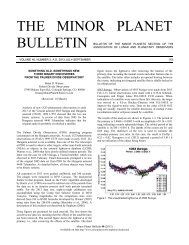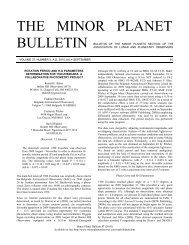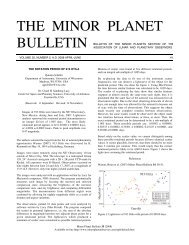THE MINOR PLANET BULLETIN - MinorPlanet.Info
THE MINOR PLANET BULLETIN - MinorPlanet.Info
THE MINOR PLANET BULLETIN - MinorPlanet.Info
- No tags were found...
Create successful ePaper yourself
Turn your PDF publications into a flip-book with our unique Google optimized e-Paper software.
127<br />
ASTEROID LIGHTCURVE ANALYSIS AT <strong>THE</strong> VIA<br />
CAPOTE OBSERVATORY: 2009 1ST QUARTER<br />
James W. Brinsfield<br />
Via Capote Observatory<br />
5180 Via Capote, Thousand Oaks CA 91320<br />
jbrinsfi@gmail.com<br />
References<br />
Harris, A.W., Young, J.W., Bowell, E., Martin, L.J., Millis, R.L.,<br />
Poutanen, M., Scaltriti, F., Zappala, V., Schober, H.J., Debehogne,<br />
H., and Zeigler, K.W., (1989). “Photoelectric Observations of<br />
Asteroids 3, 24, 60, 261, and 863.” Icarus 77, 171-186.<br />
(Received: 2009 Apr 10)<br />
Lightcurves for 4 asteroids were measured at the Via<br />
Capote Observatory from 2009 January through March:<br />
1254 Erfordia (P = 12.287 h), 2678 Aavasaksa (P >24<br />
h), 2679 Kittisvaara (P = 10.123), 4606 Saheki (P =<br />
5.032).<br />
Observations of 4 asteroids were made using a Meade LX200<br />
0.35-m Schmidt-Cassegrain working at f/10. The CCD imager was<br />
an Alta U6 featuring a 1024x1024 array of 24-micron pixels. All<br />
observations were made unfiltered at 1x binning yielding an image<br />
scale of 1.44” per pixel. All images were dark and flat field<br />
corrected. Images were measured using MPO Canopus (Bdw<br />
Publishing) and differential photometry. The data were light-time<br />
corrected. Period analysis was also done with Canopus,<br />
incorporating the Fourier analysis algorithm developed by Harris<br />
(1989). Target selections were made using the Collaborative<br />
Asteroid Lightcurve Link (CALL) web-site and “Lightcurve<br />
Opportunities” articles from the Minor Planet Bulletin. Priority<br />
was given to asteroids that did not have a published rotational<br />
period. The results are summarized in the table below and include<br />
average phase angle information across the observational period.<br />
Where 3 numbers are indicated for phase angle, measurements of<br />
the target occurred over opposition. The middle value is the<br />
minimum phase angle observed and the two end values are the<br />
phase angles at the beginning and end of the observing campaign.<br />
Individual lightcurve plots along with additional comments, as<br />
required, are also presented.<br />
None of the four targets studied during the reporting period have<br />
published lightcurves. 1254 Erfordia exhibits and interesting<br />
departure on its ascending node around phase 0.65, perhaps the<br />
effects of an impact crater on one end of the object. Observations<br />
of 2678 Aavasaksa were interrupted during the second session of<br />
the campaign due to equipment malfunction. With only limited<br />
partial coverage of the target, the continuous rising amplitude of<br />
the first session over approximately 6 hours would suggest a<br />
rotation period of greater than 24 hours and amplitude greater than<br />
0.35 mag. The longer of the two observing sessions are plotted in<br />
this report.<br />
Acknowledgments<br />
The author whishes to thank Brian Warner for his assistance with<br />
interpreting the lightcurve shape of 1254 Erfordia.<br />
# Name<br />
Dates Data<br />
(mm/dd/2009) Points Phase L PAB B PAB Per(h) PE Amp(m) AE<br />
1254 Erfordia 03/16-03/29 369 9.6 157 -7 12.287 0.001 0.47 0.02<br />
2678 Aavasaksa 01/05-01/06 95 3.0 108 +4 >24 hr >0.35<br />
2679 Kittisvaara 03/19-03/27 219 9.0 167 -8 10.123 0.003 0.22 0.03<br />
4606 Saheki 03/07–03/25 135 15 151 -4 5.032 0.001 0.68 0.01<br />
Table 1. Observing circumstances.<br />
Minor Planet Bulletin 36 (2009)










